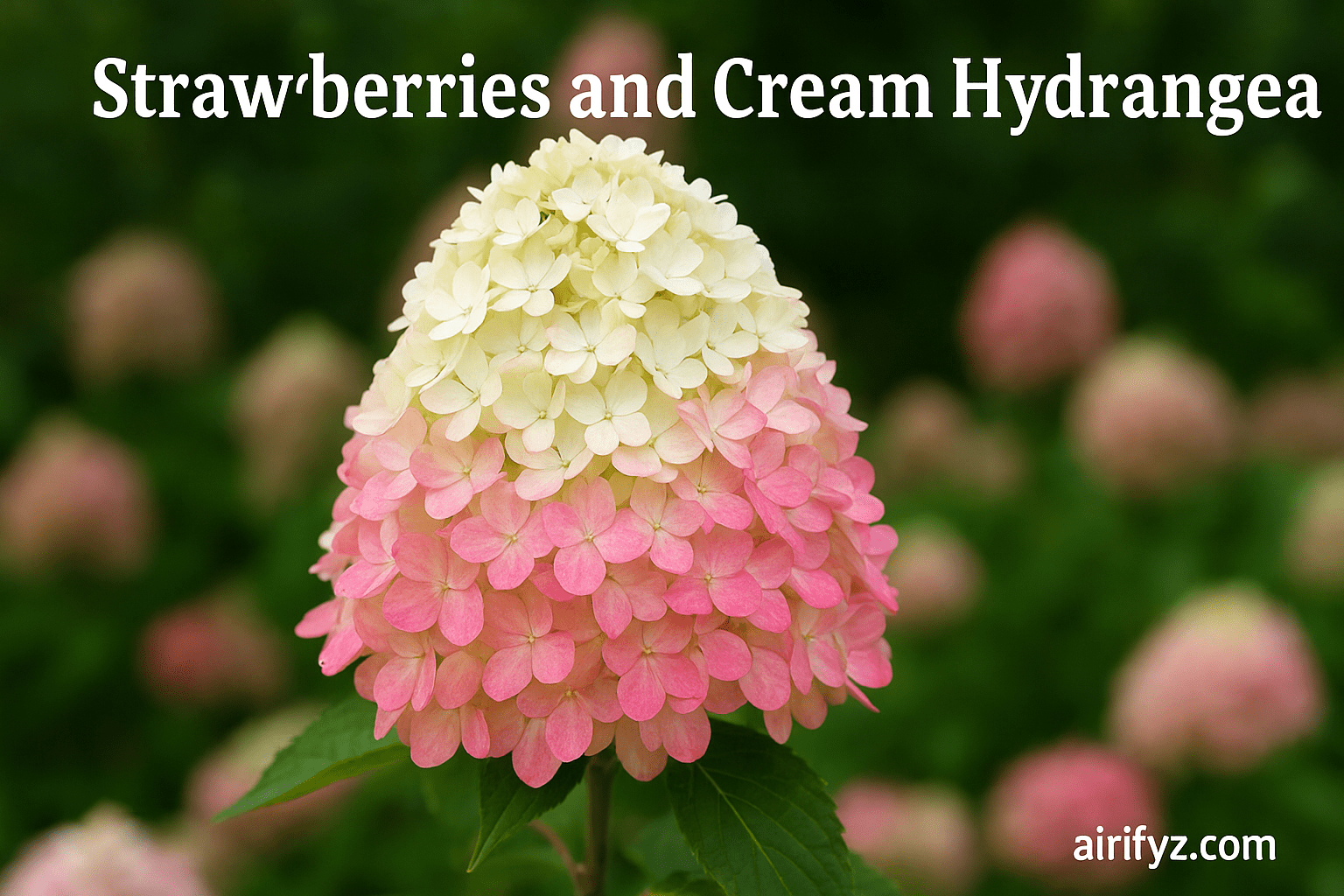INTRODUCTION:
If you’ve ever dreamed of a garden bursting with creamy white blossoms that blush into rich strawberry-pink, the Strawberries and Cream Hydrangea is the showstopper you need. This variety’s romantic colors and lush, full blooms make it a favorite for gardeners who want instant curb appeal — and with the right care, you can enjoy larger, longer-lasting blooms season after season.

Why Strawberries and Cream Hydrangea Stands Out
Not every hydrangea has the charm of soft vanilla tones blending into rosy hues. Many gardeners compare it to the “Vanilla Strawberry” variety for its stunning color transition, but Strawberries and Cream Hydrangea offers a more compact habit, making it perfect for small gardens, borders, and even patio containers.
Its blooms aren’t just pretty — they last. Whether in the garden or as cut flowers indoors, these blossoms can hold their color for weeks, especially with the right soil, sunlight, and moisture balance.
Planting for Success
1. Choose the Right Location
Put your hydrangea where it gets sunlight in the morning and shade in the afternoon. This combination provides enough light for strong blooms without the risk of midday sun scorch.
💡 Expert Tip: If you live in a hot climate, protect your plant during peak summer heat with a shade cloth or by planting near taller shrubs for dappled light.
2. Soil Preparation
Hydrangeas thrive in rich, well-draining soil. Before planting:
-
Mix in organic compost for nutrients.
-
Test your soil’s pH (more acidic soil can deepen pink tones slightly, but this variety’s color remains mostly stable).
-
Avoid waterlogged spots to prevent root rot.
Watering Routine for Bigger Blooms
Deep, consistent watering is key. Rather than light sprinkles, give your plant a slow, thorough soak 1–2 times per week.
🌱 Pro Tip: Add 2–3 inches of mulch around the base to lock in moisture, regulate soil temperature, and prevent weeds from stealing nutrients.
Fertilizing for Maximum Flower Power
A well-timed feeding schedule can make the difference between average blooms and truly impressive flower heads:
-
Early Spring: Apply a slow-release balanced fertilizer (10-10-10).
-
Midseason: Top dress with compost or a low-nitrogen liquid feed when buds form.
-
Avoid Late-Season High-Nitrogen Fertilizers: They promote leafy growth instead of flowers.
Pruning Without Sacrificing Blooms
Pruning depends on your plant’s type:
-
Panicle hydrangeas (like many Strawberries and Cream cultivars) bloom on new wood — prune in late winter or early spring.
-
Bigleaf varieties bloom on old wood — prune immediately after flowering to avoid cutting next year’s buds.
When in doubt, remove only dead, damaged, or crossing stems.
Container Growing Tips
Strawberries and Cream Hydrangea grows beautifully in pots:
-
Use a premium potting mix for good drainage.
-
Water more frequently than in-ground plants (containers dry out faster).
-
Fertilize monthly during the growing season.
-
Move pots to adjust sunlight exposure through the seasons.
Pests and Disease Prevention
While generally low-maintenance, this hydrangea can face:
-
Aphids and spider mites — treat early with horticultural oil.
-
Powdery mildew and leaf spot — improve air circulation and avoid wetting foliage late in the day.
-
Root rot — avoid standing water and plant in well-drained soil.
Seasonal Care Calendar
Spring: Fertilize, mulch, and prune if needed.
Summer: Maintain deep watering, feed lightly when buds form, deadhead for tidiness.
Fall: Allow some blooms to remain for winter interest, clean up fallen leaves.
Winter: Protect young plants with mulch in colder zones.
Real Gardener Experience
Last year, I planted three Strawberries and Cream Hydrangeas along a walkway. The first season, blooms were modest. The second year, after sticking to a deep-watering schedule, adding compost in spring, and pruning at the right time, the blooms nearly doubled in size — and neighbors kept stopping to ask what variety they were.
Expert Insight
“The key to hydrangea success is consistency — steady moisture, correct pruning, and balanced feeding. Once a plant trusts its environment, it rewards you with show-stopping blooms.”
— Emily Harris, Horticultural Specialist
You can also read about: Sunflower and Hydrangea Who Is the Best? Shocking Answer
Final Checklist for Huge Blooms
-
Morning sun, afternoon shade
-
Rich, well-drained soil with compost
-
Deep watering 1–2 times weekly
-
Spring slow-release fertilizer + midseason light feeding
-
Prune according to variety type
With these steps, your Strawberries and Cream Hydrangea will reward you with breathtaking blooms year after year.
5 Frequently Asked Questions
1. How do I get bigger blooms on my Strawberries and Cream Hydrangea?
Feed in spring, water deeply, and prune correctly for your plant type.
2. What’s the best sun exposure?
Morning sun with afternoon shade protects color and prevents scorching.
3. Can I grow it in a pot?
Yes — just water more often and feed monthly during the growing season.
4. Does soil pH change the color?
Only slightly. This variety is bred for stable pink and cream tones.
5. When should I prune?
For panicle types — late winter; for bigleaf types — immediately after flowering.



